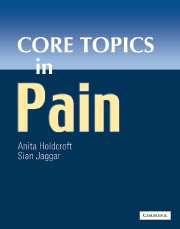Book contents
- Frontmatter
- Contents
- Contributors
- Preface
- Acknowledgements
- Foreword
- General abbreviations
- Basic science abbreviations
- PART 1 BASIC SCIENCE
- PART 2 PAIN ASSESSMENT
- Section 2a Pain measurement
- Section 2b Diagnostic strategies
- 11 Principles of pain evaluation
- 12 Pain history
- 13 Psychological assessment
- PART 3 PAIN IN THE CLINICAL SETTING
- Section 3a Clinical presentations
- Section 3b Pain syndromes
- PART 4 THE ROLE OF EVIDENCE IN PAIN MANAGEMENT
- PART 5 TREATMENT OF PAIN
- Section 5a General Principles
- Section 5b Physical treatments
- Section 5c Pharmacology
- Section 5d Psychosocial
- PART 6 SUMMARIES
- Glossary
- Index
11 - Principles of pain evaluation
from Section 2b - Diagnostic strategies
Published online by Cambridge University Press: 10 December 2009
- Frontmatter
- Contents
- Contributors
- Preface
- Acknowledgements
- Foreword
- General abbreviations
- Basic science abbreviations
- PART 1 BASIC SCIENCE
- PART 2 PAIN ASSESSMENT
- Section 2a Pain measurement
- Section 2b Diagnostic strategies
- 11 Principles of pain evaluation
- 12 Pain history
- 13 Psychological assessment
- PART 3 PAIN IN THE CLINICAL SETTING
- Section 3a Clinical presentations
- Section 3b Pain syndromes
- PART 4 THE ROLE OF EVIDENCE IN PAIN MANAGEMENT
- PART 5 TREATMENT OF PAIN
- Section 5a General Principles
- Section 5b Physical treatments
- Section 5c Pharmacology
- Section 5d Psychosocial
- PART 6 SUMMARIES
- Glossary
- Index
Summary
A working knowledge of pain evaluation is critical, because it serves to:
Monitor the clinical condition over time.
Analyse changes in response to treatment.
Advance the principles and practice of pain management.
Moreover, The Joint Commission on Accreditation of Healthcare Organizations (JCAHO) set a standard in 2000 for all healthcare organizations. It stated that all patients have a right to appropriate assessment (and management) of pain. As with all medical interactions, such evaluation will involve history, examination and appropriate special investigations.
Issues in pain measurement
The International Association for the Study of Pain (IASP) definition of pain states that ‘Pain is an unpleasant sensory and emotional experience associated with actual or potential tissue damage, or described in terms of such damage’. Full assessment therefore requires:
Multidimensional approaches to pain evaluation.
An awareness that it is not necessary to be able to visualize an obvious nociceptive stimulus (directly, or by means of special investigations) for spontaneous pain or a central sensitization evoked response to occur.
Both the over-worked clinician and wider society frequently overlook these central features. Medical and para-medical staff are commonly observed utilizing unidimensional (e.g. visual analogue scale (VAS) and verbal rating scale (VRS)) pain assessment tools, thus failing to address other components of pain, for example affective and cognitive responses.
- Type
- Chapter
- Information
- Core Topics in Pain , pp. 81 - 84Publisher: Cambridge University PressPrint publication year: 2005



